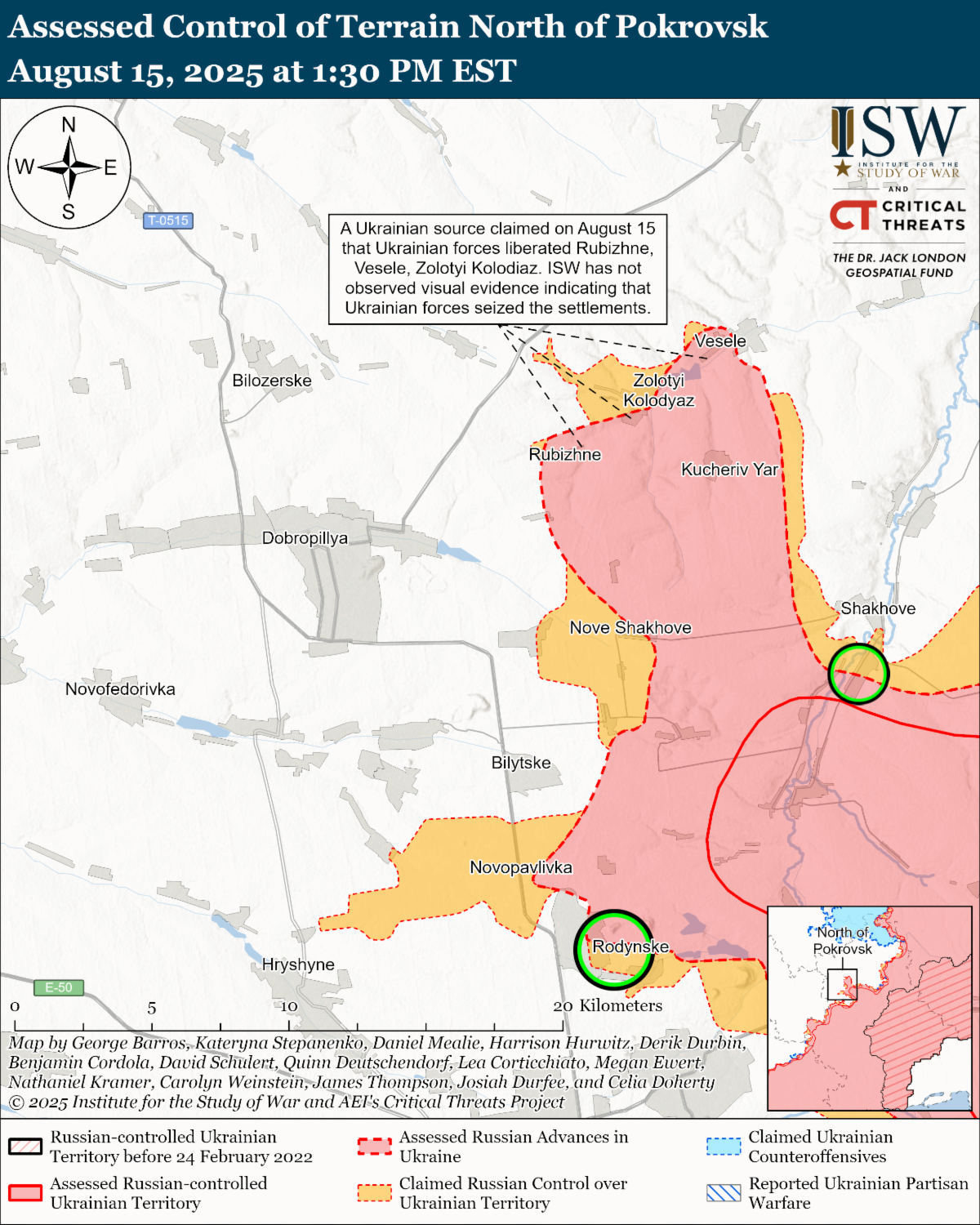US President Donald Trump met with Russian President Vladimir Putin at Joint Base Elmendorf-Richardson in Anchorage, Alaska, on August 15. Trump and Putin initially planned to meet one-on-one, but the talks expanded to a three-on-three format including Russian Foreign Minister Sergei Lavrov, Russian Presidential Aide Yuri Ushakov, US Secretary of State Marco Rubio, and US Special Envoy for the Middle East Steve Witkoff, for unspecified reasons. Leading Russian negotiator and Russian Direct Investment Fund (RDIF) CEO Kirill Dmitriev claimed that the talks went "remarkably well" following the three-on-three discussions. Trump and Putin then held a joint press conference. Putin addressed the crowd first and spoke in Russian, reiterating several long-standing Kremlin information operations about the war in Ukraine, Russian history, and the US-Russia relationship. Putin invoked the geographical closeness of Alaska and the Russian Federation and called back to US-Soviet military cooperation during the Second World War in order to artificially highlight bilateral US-Russia relations. Putin emphasized the importance of solving the "root causes" of the war in Ukraine, which the Kremlin has defined as NATO's eastward expansion and Ukraine's alleged discrimination against Russian-speakers.
Putin said nothing in the joint press conference to indicate that he has moderated either his war aims or his willingness to compromise on them and reiterated language he has used since 2021 to justify Russia's aggression against Ukraine. Putin again demonstrated that he has not changed his views on Ukrainian sovereignty since 2021 and remains disinterested in serious peace negotiations with Ukraine. Putin used the joint press conference following the August 15 Alaska summit to evoke the Kremlin's long-standing narrative that Russia and Ukraine share the "same roots" and that Russia considers Ukraine to be a "brotherly" nation. Putin published an essay on the "Historic Unity of Russians and Ukrainians" in July 2021, in which he similarly ideologized that Ukrainians and Belarusians have always belonged to the Russian nation because of their shared "historical and spiritual space."
Trump stated that the United States and Russia did not come to a firm agreement about the war in Ukraine. Trump reported that he and Putin "made great progress" and agreed on "many points" but did not agree on other points. Trump did not elaborate on the specifics of what the US and Russian delegations discussed, upon what points the delegations agreed, and which points remain in contention. Trump stated that "there's no deal until there's a deal" and stated that he will inform Ukrainian President Volodymyr Zelensky and NATO states about the conversation and that an agreement on Ukraine is "ultimately up to them." Trump reiterated his timeline that any bilateral economic agreements with Russia will come after the war is "over with."
Russia conducted drone and missile strikes in Ukraine in the hours before the August 15 Alaska summit, causing civilian casualties and damage to civilian infrastructure. The Ukrainian Air Force reported that Russian forces launched two Iskander-M ballistic missiles from Voronezh and Bryansk oblasts and 97 Shahed-type and decoy drones from the direction of Kursk, Oryol, and Bryansk cities; Primorsko-Akhtarsk, Krasnodar Krai; and Shatalovo, Smolensk Oblast on the night of August 14 to August 15. Russian forces used drones to target frontline areas of Sumy, Kharkiv, Donetsk, and Chernihiv oblasts, and the missiles to target Kharkiv and Chernihiv oblasts. The Ukrainian Air Force reported that Ukrainian forces shot down or suppressed 63 Shahed-type and decoy drones over northern and eastern Ukraine. The Ukrainian Air Force reported that the two Iskander-Ms and 34 drones struck 13 locations throughout Ukraine. Ukrainian officials reported that the ballistic missiles hit cars in Dniprovskyi Raion, Dnipropetrovsk Oblast, and an agricultural enterprise in Koryukivka Hromada, Chernihiv Oblast, killing and wounding civilians. | 





 [ISW] 이란 업데이트, 2025년 8월 15일
[ISW] 이란 업데이트, 2025년 8월 15일